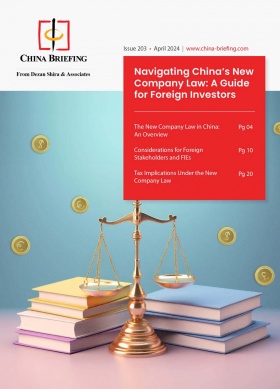China’s Economy Expands 5.3% in Q1 2024
China Q1 2024 GDP growth beat forecasts thanks to high output and activity in key manufacturing and service sectors, setting the country on track to achieving its annual economic growth targets. Several areas of the economy continued to recover between January and March following many months of low growth, including foreign trade and added value output of foreign and private companies. We break down the latest economic indicators and discuss China’s growth prospects in 2024.
China’s economy is off to a strong start in 2024, with overall GDP growth exceeding annual growth targets thanks to strong performances in the industrial and services sectors. Quarterly economic data released by the National Bureau of Statistics shows several areas of the economy expanded, including industrial output, retail sales, and foreign trade.
Looking at a monthly basis, some indicators recorded slowed growth in March compared to the previous two months, due mostly to a high base effect from March 2023, when the lifting of COVID-19 restrictions allowed economic activity and consumption to recover leading to a surge in various economic indicators.
China’s economy and society in Q1 2024 at a glance:
- GDP: RMB 29.63 trillion (US$4.1 trillion); +5.3% y/y
- Retail sales: RMB 12 trillion (US$1.66 trillion); +4.7%
- Industrial added value*: +4.5%
- Services added value: +5%
- Foreign trade: RMB 10.17 trillion (US$1.4 trillion): +5%
- Fixed asset investment: RMB 10 trillion (US$1.38 trillion); +4.5%
- Disposable income per capita: RMB 11,539 (US$1,594); +6.2%
- Unemployment rate: 5.2%;
- CPI: 0%
*Added value of companies with an annual main business income of over RMB 20 million (US$2.8 million)
China Q1 2024 GDP growth
China’s GDP in the first quarter of 2024 reached RMB 29.63 trillion (US$4.1 trillion) according to preliminary calculations. This is an increase of 5.3 percent from the previous year and an increase of 1.6 percent from the previous quarter when calculated at constant prices.
The secondary industry (industry and manufacturing) saw the highest growth rate, increasing 6 percent year-on-year to reach RMB 10.98 trillion (US$1.52 trillion). The tertiary sector (services), meanwhile, grew 5 percent year-on-year while the primary sector (agriculture and resource extraction) grew 3.3 percent year-on-year.
Industrial output continues strong momentum
The added value of industries above the designated size (companies with an annual main business income of above RMB 20 million) grew 6.1 percent year-on-year, a slight acceleration from the previous quarter. However, growth slowed to 4.5 percent year-on-year in March from the 7 percent growth rate recorded in January and February.
Meanwhile, the added value of manufacturing grew by 5.1 percent year-on-year in the first quarter of 2024, a slight deceleration from the 5.3 percent rate recorded in the fourth quarter of 2023. The added value of high-tech manufacturing increased by 7.5 percent year-on-year in the first quarter, accelerating by 2.6 percentage points from the previous quarter.
Both automotive and electronics manufacturing maintained high levels of growth in March 2024, despite a slight deceleration from January to February.
Looking at company ownership, state-owned enterprises (SOEs) in the industrial sector continued to perform well in the first quarter of 2024, although growth in added value slowed in the first few months of 2024 from the last two months of 2023. In the first quarter of 2024, the added value of SOEs increased by 5.2 percent year-on-year, a deceleration from 6.5 percent growth in the previous quarter. In March 2024, the increase in added value of SOEs slowed to 4.1 percent year-on-year, compared to 5.8 percent year-on-year in January and February 2024.
The added value of foreign-invested enterprises (FIEs) (including companies from Hong Kong, Macao, and Taiwan) improved significantly since November 2023, although growth has decelerated in recent months.
In the first quarter of 2024, the added value of FIEs in the industrial sector grew 4.8 percent year-on-year, accelerating from a 4.1 percent year-on-year increase in the previous quarter. However, in March, the added value of FIEs slowed to 2.6 percent year-on-year, compared to 6.2 percent year-on-year growth recorded in January and February and 6.9 percent year-on-year in December 2023. Nonetheless, the growth rate in the first quarter of 2024 is significantly higher than the year-long average recorded in 2023 of just 1.4 percent year-on-year growth in added value, indicating a significant recovery in the activity of foreign companies.
Private domestic enterprises show a similar trend, with added value up 5.4 percent year-on-year, accelerating to 6.5 percent in January and February 2024 before slowing to 3.7 percent growth in March 2024.
Meanwhile, the manufacturing purchasing manager’s index (PMI) rebounded to 50.8 percent in March 2024, signaling a return to expansion after five months below 50 percent. Among 21 industries surveyed, 15 showed expansion, indicating significant growth. High-tech and equipment manufacturing PMI increased to 53.9 percent and 51.6 percent respectively. All enterprise sizes, especially small ones, saw improved conditions. Efforts to stabilize the economy and boost domestic demand led to significant rebounds in market indices, notably the new export orders index. Non-manufacturing sector activity rose to 53 percent, driven by sectors like wholesale and transportation, reflecting a robust business environment.
Services production maintains steady growth
In the first quarter of 2024, the added value of the service industry increased by 5 percent year-on-year, a slight deceleration from 5.3 percent year-on-year in the last quarter of 2024.
The service industries with the highest growth in added value include the information transmission, software, and IT services industry, which increased by 13.7 percent year-on-year, the leasing and business services industry, up 10.8 percent year-on-year, the transportation, warehousing, and postal industry and the hospitality and catering industry, which each grew 7.3 percent year-on-year. Finally, the wholesale and retail industry increased by 6 percent year-on-year.
From January to February, the operating income of service industry enterprises above the designated size (those with a main annual business income above RMB 20 million) increased by 12 percent year-on-year, accelerating by 3.7 percentage points from the previous year. In March, the business activity index of the service industry was 52.4 percent, up 1.4 percentage points from the previous month, while the business activity expectation index reached 58.2 percent. Among them, the business activity index of postal services, telecommunications, radio, television and satellite transmission services, monetary and financial services, capital market services, and other industries exceeded 60 percent.
Retail sales maintain momentum while disinflationary pressures persist
Growth in consumption has slowed but remained steady at the beginning of 2024.
In the first quarter of 2024, retail sales of consumer goods reached a total of RMB 12 trillion (US$1.66 trillion), an increase of 4.7 percent year-on-year. This is a deceleration from 8.4 percent year-on-year growth in the last quarter of 2023 and from 5.5 percent in the first two months of 2024.
The vast majority – around 89 percent – of retail sales were made up of merchandise sales, which reached RMB 10.68 trillion (US$1.48 trillion) in the first quarter, an increase of 4 percent year-on-year. Merchandise sales reached a total of RMB 3.5 trillion (US$483.55 billion) in March 2024, with growth slowing to just 2.7 percent year-on-year to 4.6 percent year-on-year over the prior two months.
Meanwhile, catering revenue in the first quarter grew by 10.8 percent year-on-year to RMB 1.34 trillion (US$185.13 billion), an increase of 10.8 percent year-on-year. In March, catering revenue grew 6.9 percent year-on-year, a deceleration from 12.5 percent in January and February.
From January to March, online retail sales reached RMB 3.3 trillion (US$469.7 billion), a year-on-year increase of 12.4 percent year-on-year, slowing from 15.3 percent from January to February. Among them, online merchandise sales reached RMB 2.8 trillion (US$386.84 billion), an increase of 11.6 percent year-on-year, accounting for 23.3 percent of total merchandise sales (online and offline). Among the online retail sales of physical goods, food, clothing, and household goods increased by 21.1 percent, 12.1 percent, and 9.7 percent year-on-year, respectively.
Inflation in China continues to remain low due to a combination of weak domestic demand and strong supply-side output.
In the first quarter of 2024, the national consumer price index (CPI) remained flat year-on-year. Various products saw price decreases, including:
- Food, tobacco, and alcohol decreased by 1.7 percent; of which
- Fresh fruits fell by 7.3 percent
- Pork fell by 7 percent
- Fresh vegetables fell by 3.9 percent
- Transportation and communication decreased by 1.4 percent
Meanwhile, other products saw modest increases in CPI:
- Clothing increased by 1.6 percent
- The price of housing increased by 0.2 percent
- The price of daily necessities and services increased by 0.8 percent
- The price of education, culture, and entertainment increased by 2.3 percent
- Medical care increased by 1.4 percent
Meanwhile, core CPI, which excludes food and energy prices, rose 0.7 percent year-on-year. In March, the national consumer price increased by 0.1 percent year-on-year and decreased by 1 percent from the previous month.
Foreign trade rebounds in Q1 but falls in March
China’s foreign trade has rebounded significantly in recent months after a year of low imports and exports. In the first quarter, the total import and export of goods reached RMB 10.17 trillion (US$1.41 trillion), up 5 percent year-on-year. This is the highest growth rate recorded in the last six quarters and a significant acceleration from 1.6 percent year-on-year in the fourth quarter of 2023. Of the total trade, exports reached RMB 5.74 trillion (US$793 billion), up 4.9 percent, while imports reached RMB 4.4 trillion (US$607.89 billion), up 5 percent year-on-year.
However, despite a major improvement in foreign trade in January and February, foreign trade in March fell once again by 1.3 percent year-on-year. This was due mainly to a 3.8 percent year-on-year drop in exports, while imports slowed to 2 percent year-on-year growth from 6.7 percent in January and February.
The export of mechanical and electrical products in the first quarter of 2024 increased by 6.8 percent year-on-year, accounting for 59.2 percent of total exports.
China’s economic outlook in 2024
In its 2024 Government Work Report (GWR), China set a GDP growth target of “around 5 percent” for the year, mirroring the goal established in 2023. This target surpasses the expectations of some international institutions like the IMF and JPMorgan, which forecasted growth rates slightly below 5 percent. The continuity of this ambitious target reflects the confidence of Chinese policymakers in the resilience and potential of the nation’s economy.
However, achieving this growth target in 2024 poses challenges compared to the previous year. Despite a robust performance in 2023, the high base effect necessitates sustaining an upward trajectory to maintain a similar growth rate. While the first-quarter GDP figures of 5.3 percent surpassed estimates, the IMF notes structural pressures such as weaknesses in the property sector, which could impact the overall growth outlook. Nonetheless, the IMF has suggested it may revise its forecast upward from the current 4.6 percent based on the latest data.
Despite initial third-party projections falling short of the official target, revisions by major banks like ANZ, DBS Bank, Societe Generale, and Deutsche Bank to between 4.9 and 5.2 percent signal growing optimism, with forecasts now aligning more closely with the government’s goal. This indicates evolving sentiment and a potential upward revision in overall growth projections.
About Us
China Briefing is one of five regional Asia Briefing publications, supported by Dezan Shira & Associates. For a complimentary subscription to China Briefing’s content products, please click here.
Dezan Shira & Associates assists foreign investors into China and has done so since 1992 through offices in Beijing, Tianjin, Dalian, Qingdao, Shanghai, Hangzhou, Ningbo, Suzhou, Guangzhou, Haikou, Zhongshan, Shenzhen, and Hong Kong. We also have offices in Vietnam, Indonesia, Singapore, United States, Germany, Italy, India, and Dubai (UAE) and partner firms assisting foreign investors in The Philippines, Malaysia, Thailand, Bangladesh, and Australia. For assistance in China, please contact the firm at china@dezshira.com or visit our website at www.dezshira.com.
- Previous Article China’s Draft Certification Standards for Cross-Border Personal Information Transfer (Updated)
- Next Article China to Relax Foreign Ownership Limits in Value-Added Telecommunication Services


























